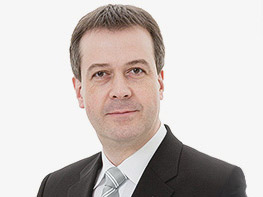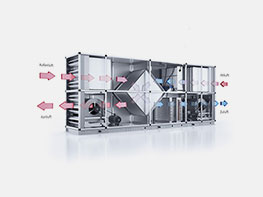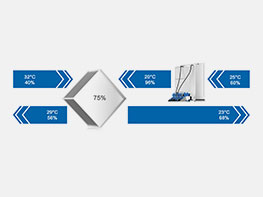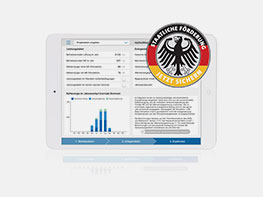Evaporative cooling receives BAFA funding for the first time
Technology, Performance and Cost-effectiveness
of Indirect Evaporative Cooling
Various technical lists of rules recommend indirect evaporative cooling for air cooling in AHUs as an alternative to the operation of water cooling units. Despite this, less than 10% of the AHUs sold in Germany have so far been equipped with this ecological and economical technology.
Since evaporative cooling has now been included in the new version of the BAFA Refrigeration and Air Conditioning Directive since 1 January 2019 and is therefore eligible for funding, as are refrigeration systems with natural refrigerants, many experts are expecting a significant increase in this environmentally-friendly air cooling technology.
In AHUs, outside air is conditioned to the desired supply air condition after filtering and heat recovery based on demand. The air is cooled and dehumidified in the cooler of the AHU, which receives the required cold water from a water cooling unit. The aim of indirect evaporative cooling is to generate as much cooling capacity as possible by evaporating water on the exhaust air side, thereby replacing the water chiller or at least reducing its air cooling capacity. This saves electrical energy and the associated CO
2 emissions, reduces greenhouse emissions from refrigerants into the environment due to leaks in water cooling units and lowers the operating costs for air cooling.
Indirect evaporative cooling is recommended as an environmentally-friendly alternative to mechanical cooling, for example, in DIN EN 13053 “Zentrale raumlufttechnische Geräte” [Central air handling units] (2017) and in the AMEV [Mechanical and electrical engineering working group of state and municipal administrations] guideline “RLT-Anlagenbau 2018” [AHU system design 2018]: “In the exhaust air system, the exhaust air can be cooled by 6 to 10 K through water evaporation and the cooling potential can be transferred to the supply air volume flow via the heat recovery system in accordance with the heat recovery coefficient (degree of temperature change). Through this measure, chillers and recooling plants can be designed with considerably lower capacity, or even eliminated, and require less installation space.” The draft of VDI 3803 Part 1 “Zentrale raumlufttechnische Anlagen” [Central ventilation and air-conditioning systems] (08/2018), even provides a “target formulation” (quote): “To reduce cooling in summer, the use of indirect evaporative cooling should be considered as a supplement to heat recovery on the extract air side”.
Evaporative cooling technology
To operate an evaporative cooling system, a humidification unit is used on the extract air side in the AHU upstream of the heat recovery system, which adiabatically humidifies the extract air as closely as possible to the saturation point of 100% relative humidity (Fig. 1). The evaporator in Fig. 1 on the right (Condair ME system) consists of wave-shaped polyester lamellae arranged in parallel, which are evenly sprinkled with treated water from above, which then flows slowly downwards. As the water flows through the evaporator, the exhaust air is humidified to 96% R.H.. This adiabatic humidification lowers the temperature of the exhaust air by 2.5 K per gram of water, which evaporates in the air. Depending on the temperature and relative humidity of the extract air (usually around 25 to 27°C and 55 to 65% respectively in summer when offices are used), the temperature of the extract air drops by around six to 10 K.
This means that the exhaust air in the downstream heat recovery system has a much higher capacity to extract heat from the warm outside air. Figure 3 shows an example of this. In the example shown, the indirect evaporative cooling humidifies the exhaust air (25°C) to 96%. This reduces its temperature to around 20°C. In the downstream cross-flow heat exchanger (heat recovery coefficient 75%), the exhaust air can now cool the outside air (32°C) by 9 K to about 23°C. Without evaporative cooling, there would have been a temperature reduction of the outside air by only 5.2 K to 26.8°C. This extra evaporative cooling capacity reduces the electrical energy consumption of the water cooling unit (and associated CO
2 emissions). The pre-cooled fresh air must be cooled in the downstream cooler (Fig. 1) to the desired supply air temperature of 20°C, for example.
At an air flow rate of 3 m³/s, for example, the additional temperature reduction of 3.8 K (9 K — 5.2 K) achieved by evaporative cooling corresponds to an output of almost 14 kW, which the water cooling unit therefore does not have to provide for air cooling. Depending on the operating conditions (temperatures, humidity, efficiency of heat recovery), it is quite possible that the cooling in the evaporative cooling is already sufficient to temper the outside air to the desired supply air temperature of 19 to 20°C, for example. However, evaporative cooling cannot help dehumidify the outside air, since significantly lower temperatures are required in the cooler to fall below the dew point temperature of the outside air.
Prerequisites for efficient evaporative cooling
How efficient indirect evaporative cooling actually is in practice depends mainly on the following parameters:
- The warmer and drier the exhaust air, the more intensively it can be humidified (up to about 96%) and therefore cooled.
- The more efficient the heat recovery, the more energy the warm outdoor air can transfer to the cooled exhaust air. Ecodesign Regulation 1253/2014, in force since early 2018, requires the use of a heat recovery system with a good heat recovery efficiency of at least 73% (CCS systems 68%) for all AHUs.
- If the general conditions are good (outside air < 30°C, extract air < 25°C, low humidity), indirect evaporative cooling can achieve a supply air temperature in the range of 20 to 22°C, so that mechanical post-cooling of the air is often no longer necessary.
- Since polluted (humid) extract air may be transferred to the supply air, very dense plate heat exchangers or closed-loop systems are recommended for heat recovery in evaporative cooling. Because of the system-related leakage between the extract air and fresh air side, the use of rotors must be considered.
Measuring evaporative cooling capacity
The capacity and cooling work of an evaporative cooling system is calculated below using the “my- Coolblue” program developed by Condair GmbH (
www.mycolblue.de). This allows specialist planners and AHU manufacturers to quickly and precisely determine the energy potential and savings through the operation of indirect evaporative cooling as early as the project planning of the AHU. The programme is based on three steps:
- Entering the location of the project and all desired operating data (usage times per day/week, temperature and humidity setpoints in the room). The design data and annual curves of outdoor temperatures and humidity for the 15 German reference locations and for 320 international cities are stored in the programme. The data is based on VDI 4710 “Meteorologische Grundlagen für die technische Gebäudeausrüstung” [Meteorological principles for technical building equipment] and on Meteonorm weather data. The predefined values may be changed individually.
- Input of the system data. These are the air volume flow, the expected dimensions of the AHU (air velocity in the AHU), the heat recovery system (including heat recovery index), pressure boosts, fan efficiency levels and the arrangement of the components in the AHU. This AHU configuration is displayed in a table.
- The programme calculates the following values based on the input data: Total operating hours of the AHU per year, operating hours of the evaporative cooling and the cooling capacity of the water cooling unit to be installed for air cooling with and without taking the evaporative cooling into account. It also specifies the total annual cooling capacity required for air cooling with the shares of mechanical cooling (including dehumidification), heat recovery and evaporative cooling, as well as the annual coefficient of performance of evaporative cooling. This is the ratio between the cooling capacity generated by evaporative cooling for the pump work that is required to move the evaporative water and the fan work to overcome the air-side pressure loss of the evaporative cooler.
This programme is now used to calculate examples showing the potential and performance of evaporative cooling at the Potsdam (German reference site) and Munich (Mühldorf) sites. The data regarding the outdoor air and extract air conditions is based on the reference specifications of the BAFA funding for indirect evaporative cooling (extract air: 25°C, 60% R.H.; outdoor air: 32°C, 40% R.H.). The AHU is assumed to have an air flow rate of 10,800 m3/h (3 m3/s), a cross-flow heat exchanger (heat recovery coefficient 75%), exhaust air humidification at 95%, an air velocity in the AHU of 1.7 m/s, an efficiency of the fan-motor unit of 0.6 and an operating time of the AHU of 60 h per week (3,120 h per year).
Table 1
Results of the example calculations for indirect evaporative cooling (EC) for the Potsdam and Munich sites
(Variant 1: Exhaust air humidity maximum 60%)
|
Potsdam |
Munich |
| Operating hours EC VK |
642 h/a |
573 h/a |
| Total cooling output |
20 041 kWh/a |
16 857 kWh/a |
| Cooling output, mechanical |
10 122 kWh/a |
8 128 kWh/a |
| Cooling output EC + HRS |
9 892 kWh/a |
8 729 kWh/a |
| Share of EC + HRS |
49 % |
52 % |
| Coefficient of performance EC |
4,9 |
4,4 |
| Water cooler capacity |
|
|
| Without UK |
76 kW |
75 kW |
| With UK |
70 kW |
67 kW |
The results of the calculations are summarised in Table 1 and shown in Figure 3. According to Table 1, indirect evaporative cooling including heat recovery provides about a 50% share of the air cooling output requirement at both locations per year. The annual coefficient of performance of evaporative cooling is 4.4 and 4.9, respectively. At the same time, the use of evaporative cooling can reduce the nominal capacity of the water cooling unit by 6 kW (Potsdam) and 8 kW (Munich).
While evaporative cooling takes on a large part of the sensitive air cooling, the water chiller’s capacity is an essential requirement for the air dehumidification. These statements and tendencies are confirmed by further calculations. All operating parameters of the example calculation are transferred intact and only one parameter is changed: The maximum permissible indoor air or exhaust air humidity, which was previously 60%, is increased to 70%. This leads to slightly lower thermal comfort in the rooms, but this increased indoor air humidity will only occur during very few hours per year. However, this increase in humidity contributes significantly to the reduction in the annual air cooling and dehumidification output requirement, as shown by the results in Table 2.
Table 2
Results of the example calculations for indirect evaporative cooling (EC) for the Potsdam and Munich sites
(Variant 2: Exhaust air humidity 70%)
|
Potsdam |
Munich |
| Operating hours EC |
642 h/a |
573 h/a |
| Total cooling output |
15 031 kWh/a |
12 428 kWh/a |
| Cooling output, mechanical |
5 654 kWh/a |
4 194 kWh/a |
| Cooling output EC + HRS |
9 377 kWh/a |
8 234 kWh/a |
| Share of EC + HRS |
62 % |
66 % |
| Coefficient of performance EC |
4,7 |
4,1 |
| Water cooler capacity |
|
|
| Without UK |
67 kW |
56 kW |
| With UK |
52 kW |
43 kW |
A comparison of the data in Table 1 (exhaust air humidity 60%) and Table 2 (exhaust air humidity 70%) yields the following results:
- The total air cooling output has decreased by almost 5,000 kWh/a in Potsdam and by about 4,400 kWh/a in Munich. This corresponds to a reduction of about 25% compared to the reference condition of “60% relative humidity”.
- At the same time, the cooling output proportion of evaporative cooling and heat recovery has increased to well over 60%.
- The water cooling unit now requires 15 kW (Potsdam) and 13 kW (Munich) less nominal capacity.
Savings through evaporative cooling
What savings in euro result from using evaporative cooling instead of air cooling? For this purpose, it is assumed that the water cooling unit used has a coefficient of performance of 4.0. If 9,892 kWh/ath is saved through evaporative cooling at the Potsdam site (60% R.H.), this corresponds to electrical work of
9,892: 4 = 2,473 kWh/ael (at 70% R.H. compared to reference condition 20,014 kWh/a — 5,654 kWh/a
= 14,360 kWh/ath: 4 = 3,590 kWh/ael).
At an electricity price of 18 cents/kWh, this results in savings in electrical work of 445 €/a (60% R.H.) or 646 €/a (70% R.H.). If a life cycle consideration over 15 years is taken into account, this results in savings of €6,675 and €9,690. Further savings can be achieved through the reduced nominal capacities of the water cooling units to be used. It is assumed in this instance that the investment costs incurred per kW of lower cooling capacity are cut by €300. All savings for both calculations are summarised along with the amounts of the BAFA funding in Table 3.
Table 3
Total savings in the operation of indirect evaporative cooling due to the reduction in the electrical cooling output of the water cooling unit, the lower investment for the water cooling unit (WCU) and the BAFA funding over 15 years of operation.
| Savings through |
Potsdam (60% R.H.) |
Potsdam (70% R.H.) |
Munich (60% R.H.) |
Munich (70% R.H.) |
| Electrical work |
6 675 € |
9 693 € |
5 893 € |
8 548 € |
| WCU investment |
1 800 € |
7 200 € |
2 400 € |
9 600 € |
| BAFA funding |
5 018 € |
5 018 € |
5 018 € |
5 018 € |
| Total |
13 493 € |
21 911 € |
13 310 € |
23 166 € |
The new funding guideline for refrigeration and air conditioning
Effective 1 January 2019, the Federal Ministry of Economics and Technology published a new version of the “Richtlinie zur Förderung von energieeffizienten Kälte- und Klimaanlagen mit nicht-halogenierten Kältemitteln in stationären und Fahrzeug- Anwendungen” [Guideline on the funding of energy-efficient refrigeration and air-conditioning systems using non-halogenated refrigerants in stationary and vehicle applications]. It is implemented by BAFA [Federal Office of Economics and Export Control] (www.bafa.de). According to the new directive, only new refrigeration and air-conditioning systems operated with natural refrigerants (propane, propene, isobutane, ethane, ammonia, CO
2, water), as well as absorption and adsorption refrigeration systems are eligible for funding. Indirect evaporative cooling systems have been newly included in the funding guideline. The funding amount F of a refrigeration or air conditioning system (in euros) is calculated using the equation
F = (A · XB + C) · X
Where X is the system’s nominal cooling capacity (in kW) and A, B and C are system-specific coefficients defined for each individual cooling system. For indirect evaporative cooling, the following applies: A = 3 567,45; B = – 1,0788; C = 70,79. The cooling capacity X generated by evaporative cooling is calculated for the defined conditions of outside air (32°C, 40% R.H.) and exhaust air (25°C, 60% R.H.) and the heat recovery used. If the exhaust air (25°C, 60% R.H.) is humidified to 96% in the evaporative cooling system, its temperature drops to about 20°C. Then, with a heat recovery coefficient of 75%, the cooling capacity results in
X = q · p · cp ·DT · hWRG
X = 3 m³/s · 1,2 kg/m³ · 1 006 kJ/kgK · (32 – 20) K · 0,75
X = 32,6 kW
If this value is inserted into the funding equation, for the funding, this results in
K = (3 567,45 · 32,6–1,0788 + 70,79) · 32,6 = 5 018 €
Thus, in this example, the AHU is funded by BAFA with a lump sum of €5,018, regardless of the location and other operating parameters.
Summary of savings
Overall, the operation of indirect evaporative cooling results in the savings shown in Table 3 for the AHU used as an example, both locations, both assumed humidities (60% and 70%), and over an observation period of 15 years. The data show that the use of indirect evaporative cooling in standard operation (extract air humidity 60%) results in significant savings of over€13,000 over an operating period of 15 years. These savings increase to values in the region of €22,000 to €23,000 if the operator is prepared to accept an indoor air humidity of 70% for a few hours a year.
The expenses for evaporative cooling
However, the savings in Table 3 are offset by several expenses. First of all, there is the purchase of the evaporative cooler.
In addition, there are operating costs for the required water and its treatment (treated rainwater can also be used for this purpose), the additional power consumption of the exhaust air fan (pressure loss of the evaporator) and for the water pump, costs for a more water-tight design of the heat recovery as well as service, maintenance and upkeep costs (control of water hygiene, replacement of humidifer bodies, etc.).
However, all costs and savings are highly dependent on the AHU itself (air volume flow, heat recovery coefficient, humidification capacity, operating time), the operating parameters (temperatures and humidities of supply air, extract air and outdoor air), the location (annual variation of outdoor air), the actual electricity and water prices, the coefficient of performance of the water cooling unit and the real savings when the nominal capacity of the water cooling unit is reduced.
Therefore, the previous example calculations can only show tendencies. All these factors must be determined on a project-specific basis in simulation calculations by specialist planners or AHU manufacturers who are in the evaporative cooling systems business. Based on many ventilation systems installed so far, payback periods for evaporative cooling systems have been between around three and ten years. However, this does not take into account the new BAFA funding, which now significantly improves these paybacks.
Summary
Indirect evaporative cooling offers considerable environmental and economic potential for reducing the output of the water cooling units used for air cooling in AHUs. However, evaporative cooling is hardly suitable to take on building cooling single-handedly. It is only capable of replacing a water cooling system fully in certain projects, for example in locations with cool summers. In most cases, however, the share of evaporative cooling in the total cooling work required annually for air cooling is in the range of 50 to 60%. Therefore, as recommended by several current technical set of rules, evaporative cooling should always be considered a “basic environmentally-friendly system for pre-cooling outdoor air”.
The residual or peak load for air cooling and dehumidification is taken on by the water cooling unit, which has a reduced output and is therefore cheaper. Another positive aspect is the reduction in CO
2 emissions due to the lower electricity consumption of the water cooling unit. According to Bundesumweltamt [German Environment Agency], a value of around 0.5 kg CO
2 per kWh of electricity saved can be applied here. It follows from this: If the cooling output of the water cooling unit (coefficient of performance 4) is reduced by 8,000 kWh/a, for example, this corresponds to a saving in electricity consumption of 2,000 kWh/a and a reduction in CO
2 emissions of 1 t/a. This environmental aspect is also becoming increasingly important to many companies and favours the use of evaporative cooling.
The myCoolblue calculation software is available free of charge as a browser version and as an iOS app in the AppStore.
Technology, performance and economy of indirect evaporative cooling — Frank Benndorf, Sales Condair GmbH








